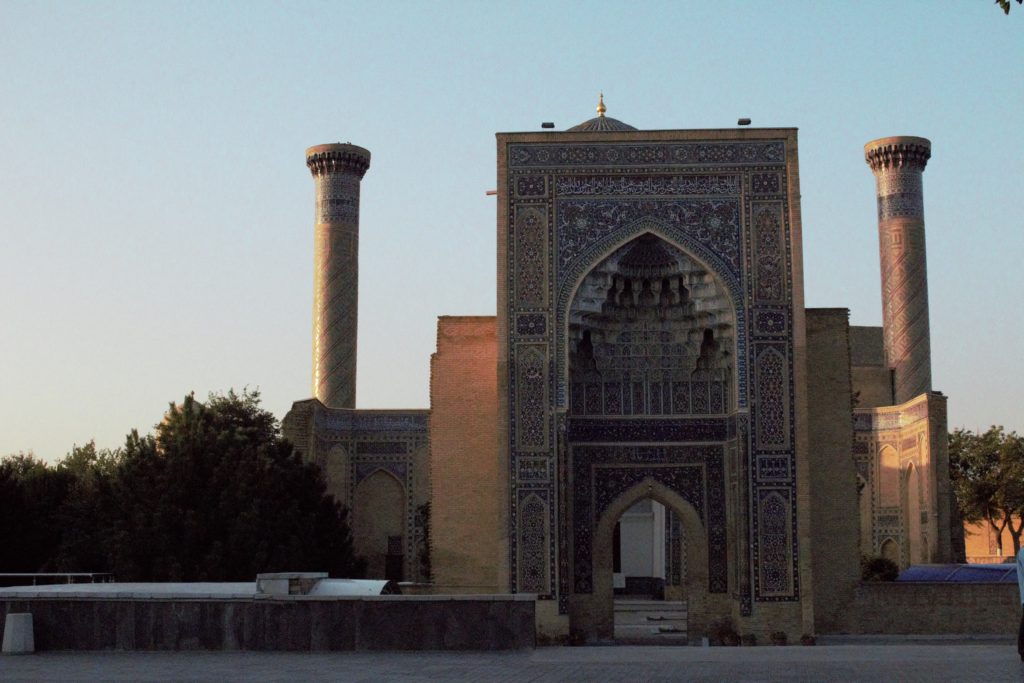The Capital of Tamerlane
Written and photographed by Cami Ismanova.
We travel not for trafficking alone;
By hotter winds our fiery hearts are fanned:
For lust of knowing what should not be known
We make the Golden Journey to Samarkand
— By James E. Flecker
Right in the heart of Central Asia stands a magnificent city known as the “Capital of Tamerlane,” or Samarqand. Its name comes from the Old Persian words asmara (stone, rock) and sogdian qand (fort, town). It means “stone fort” or “rock town.” Known as Maracanda in the 4th century B.C.E., it was the capital of Sogdiana, located on the territory of modern east-central Uzbekistan. Throughout its history, Samarqand was captured by Alexander the Great, then later ruled by Central Asian Turks, the Arabs, the Samanids of Iran, and subsequently destroyed by the Mongol conqueror Genghis Khan.
After the revolt against the Mongols, Samarqand became the capital of the Timurid Dynasty. Timur (also known as “Tamerlane”) made Samarqand the most important economic and cultural city in Central Asia. Samarqand played a crucial role in linking China and the West via the Silk Road. During the reign of Tamerlane and his descendants, Samarqand thrived. They built madrassah, mosques, city squares, and other impressive monuments of medieval architecture. Bazaars (traditional markets) were full of silk, gold, silver dishes, various fabrics, well-bred horses, and products of local and foreign craftsmen.

Minora or minaret of the Gur-E-Mir.In 1500, the city was conquered by Uzbeks and became a part of the Khanate of Bukhara. By the 18th century, the city declined and lost its economic power in the region. A virtual ghost town, it lay uninhabited for 50 years from 1720 to 1770. However, it had a chance to recover after it became a provincial city in the Russian Empire. Railroads, new infrastructure, and administration saved it from oblivion.
Now Samarqand consists of an Old City (“Eski Shahar”) and a New City (“Yangi Shahar”). The city is a historical and cultural hub of Central Asia. It carries the inheritance of so many different cultures and nations. Samarqand was named the “Crossroad of Cultures” by UNESCO in 2001, and the city now attracts tourists from all over the globe. According to the local Department of Tourism Development, in the past twelve months, 1,560,000 locals and 239,000 foreign tourists visited Samarqand. Here are some trip tips you ought to know when you decide to visit sunny Samarqand, Uzbekistan.

First of all, planning when to go is the most important part of your preparations. This is because of the continental climate in Uzbekistan, with very hot summers and extremely cold winters. I would not recommend you visit Samarqand during the summer and winter seasons. The best choice is to go during spring or autumn when the weather is nice and warm, and all bazaars are full of goods.
Secondly, you should know that attractions like “Gur-e-Amir,” “Shakh-i-Zinda,” and “Bibi-Khanum” happen to be mausoleums and mosques, which require a certain dress code, for locals take those places seriously. This is not an absolute requirement, but I assure you that local people will appreciate your respect for their culture.

Thirdly, as for expenditures, it is more convenient to use cash both at the attractions and at bazaars. You can exchange your money for the local currency (Uzbek som) at any bank (during working hours, typically 9:00–18:00). Also, hotels are pretty affordable in Samarqand. You can book an enormous room with all the facilities for around US$22 per night. Tickets to many attractions can be bought for less than US$3. In addition, you can travel to Samarqand from Tashkent (the capital of Uzbekistan) by airplane, train, car, or bus. If you prefer to get to your destination quickly, you should book a direct flight from Tashkent to Samarqand. On the other hand, if you want to see how the nature and suburbs of the country look, you should book a train ticket (the journey will take around 4.5 hours).
The must-visit attractions in Samarqand are “Gur-e-Amir,” “Registan Square,” “Bibi Khanum Mosque,” “Shaikh-i-Zinda,” “Afrasiab Settlement,” and others. “Gur-e-Amir,” which is literally translated as “The Grave of Emir,” is the mausoleum where many rulers of the Timurid Dynasty were buried, including Tamerlane himself. The walls of the mausoleum are decorated with gold and silver, making the whole place absolutely gorgeous. It offers displays showing Tamerlane’s life history. “Bibi Khanum,” the beautiful mosque, is known for being enshrouded by legends and tales of Tamerlane and his favorite wife. The yard is a peaceful place to spend time in under the shade of trees. Each place has this calm, royal atmosphere that surprisingly demonstrates not only the lives of members of the dynasty but also the lives of ordinary folks.
In conclusion, Samarqand is a magical land of historical wonders and a crossroads of cultures that carries the inheritance of all nations that resided there. It is a must-see destination for anyone visiting Central Asia.
The Author
Cami Ismanova is a student at Chonnam National University majoring in economics. She writes poems both in English and Russian as one of the ways to express herself. She also loves traveling around and reading classics.



